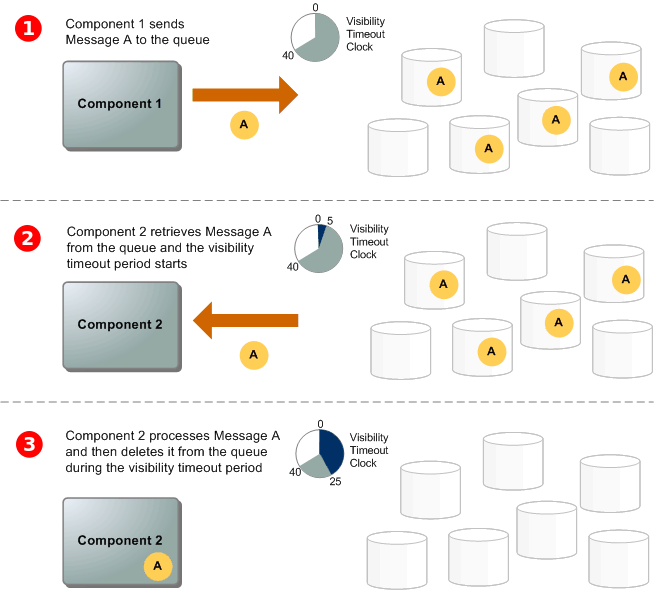WonderQ is a simplified version of Amazon's SQS. It's is a broker that allows multiple producers to write to it, and multiple consumers to read from it. It runs on a single server. Whenever a producer writes to WonderQ, a message ID is generated and returned as confirmation. Whenever a consumer polls WonderQ for new messages, it gets those messages. These messages should NOT be available for processing by any other consumer that may be concurrently accessing WonderQ.
I've created REST API endpoints for GET, POST, and DELETE for producers and consumers to use to generate and consumer messages from the WonderQ. Please see the Wiki section for further details.
Here is an example of a queue message's life cycle in SQS. WonderQ matches this minus distributing the queue onto many servers, but this could be added in the future:
In order to demonstrate the capabilities of WonderQ I've created a sample producer and two consumers under the /demo directory. First run WonderQ itself:
cd WonderQ
npm install && npm start
Next you can choose to start a producer or any of the consumers, simply navigate to one of the directories and run npm install && npm start. For example:
cd WonderQ/demo/producer
npm install && npm start
This will start a sample producer that generates a message for the queue on an interval of one second. Every time the message is successfully added to the queue, WonderQ will return a MessageID and print this to the console.
If we want to run a good consumer we can run:
cd WonderQ/demo/consumers/goodConsumer
npm install && npm start
This will cause a message to be consumed from the queue every second, then after three seconds the message will be deleted from the queue (this is used to simulate a three second processing time per message).
Finally, we can also start a bad consumer:
cd WonderQ/demo/consumers/badConsumer
npm install && npm start
This will cause messages to be consumed from the queue every second, but they will not be deleted and thus we become available for processing again after the visiblityTimeout set in WonderQ.
To test WonderQ run:
cd WonderQ
npm install && npm test
Currently WonderQ is a very simple queuing service and there is a lot of room for improvement. As of right now we're only using an in-memory array to store the queue as well as multiple for-loops to iterate through the array. Additionally, each stored message is a custom object which could be redesigned to improve performance. Here are some ideas to increase scalability:
- As a simple but hugely beneficial improvement, we could switch the queue from an array to a hash table. This would eliminate the need to iterate through the queue every time we need to delete a message
- We could also likely use this to speed up pulling an item from the queue for processing with the complication of trying to find which is the highest priority element that's also unlocked
- We may be able to use a mutex instead of our custom object to increase efficiency of locking, unlocking and searching through queue items that are currently locked
- Additionally, to increase scalability we would likely want to switch our queue to be stored in a database instead of anything in memory
- The ability for bad consumers to eventually not be able to receive messages anymore if they're constantly failing to process
- There's a number of interesting features provided in Amazon SQS that would be great to implement in WonderQ as well:
- Dead-Letter Queues to help with debugging of constantly failing messages
- Distributed queue architecture so that the so that we can handle a huge number of requests in a short amount of time if needed
- With this can come the addition of short and long polling depending on the needs of the app using the queue
- Variable visibilityTimeouts so that the we can dynamically increase efficiency of the queue depending on current processing time
